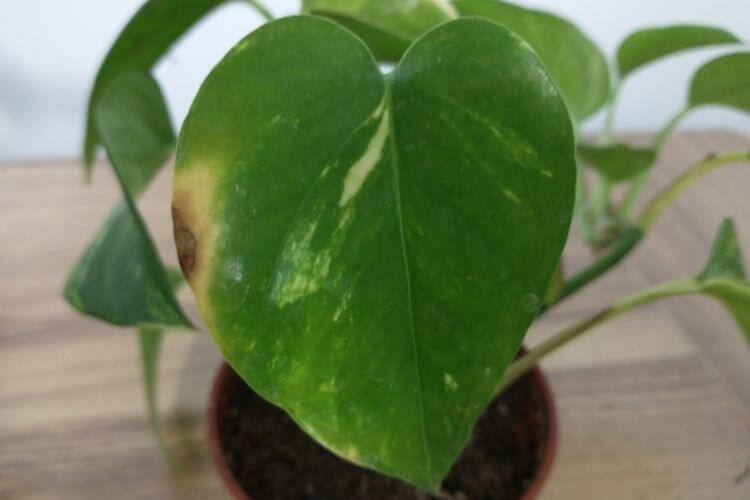Pothos is one of the most popular houseplants due to its easy care and ability to thrive in a variety of lighting conditions. However, even this hardy plant can develop issues like brown spots on its leaves.
Brown spots on pothos are typically a sign of stress and improper care. The good news is pothos are resilient plants that will often bounce back with some tweaks to their care routine.
In this article, we’ll cover the leading causes of brown spots on pothos and what you can do to remedy them.
Overwatering and Underwatering
The number one cause of pothos leaves turning brown is incorrect soil moisture. Pothos prefer to dry out a bit between waterings.
Overwatering leaves the soil soggy, promoting fungal growth which leads to root rot. Rotting roots are unable to absorb water and nutrients properly, resulting in leaf spotting and browning. Older leaves near the base of the plant show symptoms first.
Underwatering also leads to brown spots, again typically on the lowest, oldest leaves. Allowing pothos soil to completely dry out too frequently stresses the plant.
Solutions for Watering Issues
-
Check soil moisture before watering. Only water when top few inches are dry.
-
Ensure pot has drainage holes and well-draining soil mix
-
Water less frequently. Aim for every 1-2 weeks.
-
Never allow standing water in saucer after watering.
-
For root rot, trim off affected roots and repot in fresh soil.
Too Much or Too Little Light
Pothos prefer bright, indirect light. Direct harsh sunlight can scorch leaves, while too little light leads to weak growth.
Symptoms of too much light include brown spotting and crispy leaf edges. Low light shows as small leaves and yellowing.
Lighting Solutions
-
Keep pothos 3-10 feet from south or west windows. Sheer curtains filter light.
-
If direct sun is an issue, move plant to brighter indirect light location.
-
Rotate plant occasionally so all sides get light exposure.
-
Supplement with grow lights if indoor conditions are consistently dark.
Low Humidity
Pothos thrive in humidity above 50%. When humidity drops too low, brown leaf edges and tips are common.
Increasing Humidity
-
Group plants together to create a humid microclimate.
-
Use a humidifier in low humidity rooms.
-
Mist pothos leaves occasionally with room temperature water.
Pest Problems
Spider mites, mealybugs, fungus gnats, and scale can infest pothos and leave behind brown, splotchy marks on foliage. Check undersides of leaves for very small insects.
Pest Solutions
-
Isolate affected plants. Remove badly damaged leaves.
-
Wipe pests off with damp cloth or cotton swab dipped in alcohol.
-
Spray insecticidal soap or neem oil. Repeat treatments per product instructions.
-
Remove excess moisture from soil and increase air circulation.
Other Causes
-
Cold drafts – Pothos dislike temps below 60°F. Move away from cold windows and vents.
-
Over-fertilizing – Excess salts in soil leads to brown leaf tips. Flush soil every few months.
-
Bacterial infections – Show as brown splotches with yellowing. Remove infected leaves promptly.
-
Age – Older pothos leaves naturally yellow and brown. Prune these to encourage new growth.
Prevention and Maintenance
An ounce of prevention is worth a pound of cure when it comes to avoiding pothos problems.
-
Allow soil to partially dry out between waterings.
-
Provide bright, indirect light from an east or west window.
-
Keep leaf surfaces dust-free by wiping with a damp cloth.
-
Inspect frequently for signs of pests. Act quickly if found.
-
Prune off old or damaged leaves to encourage new growth.
-
Repot in fresh soil every 2-3 years as needed.
When to Worry About Brown Spots
As long as brown spots are limited to a few leaves here and there, your pothos should recover with adjusted care. But if leaf browning is extensive or you see dying stems, the plant may be beyond saving.
Rather than struggle with a plant that refuses to thrive, consider replacing it with a new pothos. They’re so affordable and forgiving!
With a pothos’ easygoing nature, issues like brown spots are usually easily corrected. A bit of investigation into improper conditions and some tweaks to their care will have your pothos back to health.
Soil and Drainage Quality
Poor drainage is like wearing wet socks; its uncomfortable and causes problems. Ensure your Neon Pothos has well-draining soil and a container that lets its feet—err, roots—breathe.
Neon Pothos despise temperature rollercoasters. Too hot or too cold, and theyll signal their displeasure with brown spots. Keep it comfy between 70°F and 90°F to avoid leaf tantrums.
Common Mistakes to Avoid
Nutrition is like a love language for plants. If you don’t give your Neon Pothos enough of it, it could have a dull love affair, showing up as brown spots on the leaves. To avoid this, dont just water and hope for the best. Fertilize judiciously, following the Goldilocks principle—not too much, not too little, but just right. And remember, your plants appetite changes with the seasons.
ABSOLUTE SOLUTION for Money Plant Leaves BLACK SPOTS (Pothos)
FAQ
Should I cut off brown pothos leaves?
How do you treat brown spots on leaves?
What does an overwatered pothos look like?
Should I cut off leaves with brown spots?
- The Ultimate Guide to Growing Strawberries in Raised Beds - August 8, 2025
- No-Dig Garden Beds: The Easiest Way to Grow a Beautiful Garden - August 6, 2025
- How to Protect and Preserve Wood for Raised Garden Beds - August 6, 2025

